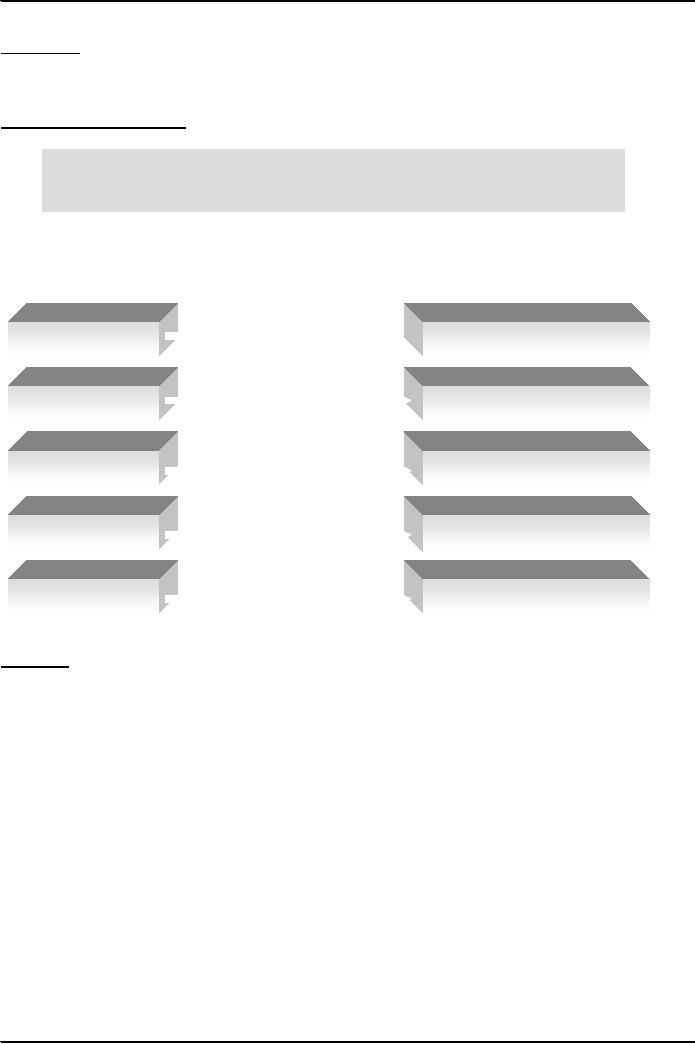 |

Strategic
Management MGT603
VU
Lesson
13
FUNCTIONS
OF MANAGEMENT:
Objectives:
This
lecture provides all the information
regarding what are the core
functions of management in a
business
firm.
Functions
of management
Functions
of Management
Strategy
Formulation
Planning
Strategy
Implementation
Organizing
Strategy
Implementation
Motivating
Strategy
Implementation
Staffing
Strategy
Evaluation
Controlling
Planning:
Planning
is the:
Start
of the process
Bridge
between present and
future
Increases
likelihood of achieving desired
results
54

Strategic
Management MGT603
VU
Planning
Forecasting
Establishing
objectives
Planning
Devising
strategies
Developing
policies
Setting
goals
The
only thing certain about the
future of any organization is change,
and planning
is the
essential bridge
between
the present and the future
that increases the likelihood of
achieving desired results. Planning is
the
process
by which one determines whether to
attempt a task, works out the most
effective way of reaching
desired
objectives, and prepares to
overcome unexpected difficulties
with adequate resources. Planning
is
the
start of the process by which an
individual or business may
turn empty dreams into
achievements.
Planning
enables one to avoid the
trap of working extremely hard
but achieving little.
Planning
is an up-front investment in success. Planning
helps a firm achieve maximum
effect from a given
effort.
Planning enables a firm to take
into account relevant factors
and focus on the critical ones.
Planning
helps
ensure that the firm can be
prepared for all reasonable
eventualities and for all
changes that will be
needed.
Planning enables a firm to gather the
resources needed and carry
out tasks in the most
efficient way
possible.
Planning enables a firm to conserve
its own resources, avoid
wasting ecological resources,
make a
fair
profit, and be seen as an effective,
useful firm. Planning enables a
firm to identify precisely what is to
be
achieved
and to detail precisely the who,
what, when, where, and
why needed to achieve
desired objectives.
Planning
enables a firm to assess whether the
effort, costs and implications
associated with
achieving
desired
objectives are warranted. Planning is the
cornerstone of effective strategy
formulation. But even
though
it is considered the foundation of
management, it is commonly the task that
managers neglect
most.
Planning
is essential for successful
strategy implementation and
strategy evaluation, largely
because
organizing,
motivating, staffing, and controlling
activities depend upon good
planning.
The
process of planning must
involve managers and
employees throughout an organization. The
time
horizon
for planning decreases from
two to five years for
top-level to less than six
months for lower-level
managers.
The important point is that
all managers do planning and
should involve subordinates in
the
process
to facilitate employee understanding and
commitment.
Planning
can have a positive impact
on organizational and individual
performance. Planning allows an
organization
to identify and take
advantage of external opportunities and
minimize the impact of external
threats.
Planning is more than extrapolating from
the past and present into
the future. It also
includes
developing
a mission, forecasting future
events and trends,
establishing objectives, and
choosing strategies
to
pursue.
An
organization can develop synergy through
planning. Synergy
exists
when everyone pulls together as a
team
that knows what it wants to achieve;
synergy is the 2 1 2 5 5 effect. By establishing
and communicating
clear
objectives, employees and
managers can work together
toward desired results.
Synergy can result in
powerful
competitive advantages. The
strategic-management process itself is
aimed at creating synergy in
an
organization.
55

Strategic
Management MGT603
VU
Planning
allows a firm to adapt to
changing markets and thus
shape its own destiny.
Strategic management
can
be viewed as a formal planning process
that allows an organization to pursue
proactive rather than
reactive
strategies. Successful organizations
strive to control their own futures
rather than merely react
to
external
forces and events as they
occur. Historically, organisms
and organizations that have
not adapted to
changing
conditions have become
extinct. Swift adaptation is needed today
more than ever before
because
changes
in markets, economies, and competitors
worldwide are
accelerating.
Organizing:
Achieve
coordinated effort
Defining
task and authority
relationships
Departmentalization
Delegation
of authority
Organizing
Organizational
design
Organizational
design
Organizational
design
JJob specialization
ob
specialization
Job
specialization
Job
descriptions
Job
descriptions
Job
descriptions
JJob specifications
ob
specifications
Job
specifications
Span
of
control
Span
of
control
Span
of control
Organizing
Organizing
Organizing
Unity
of ccommand
Unity
of
command
Unity
of ommand
Coordination
Coordination
Coordination
Job
design
Job
design
Job
design
Job
analysis
Job
analysis
Job
analysis
The
purpose of organizing
is to
achieve coordinated effort by defining
task and authority
relationships.
Organizing
means determining who does what
and who reports to whom. There are
countless examples in
history
of well-organized enterprises successfully competing
against, and in some cases
defeating, much
stronger
but less-organized firms. A well-organized
firm generally has motivated
managers and
employees
who
are committed to seeing the organization
succeed. Resources are
allocated more effectively
and used
more
efficiently in a well-organized firm than
in a disorganized firm.
The
organizing function of management can be
viewed as consisting of three
sequential activities: breaking
tasks
down into jobs (work
specialization), combining jobs to
form departments (departmentalization),
and
delegating
authority. Breaking tasks down
into jobs requires development of
job descriptions and
job
specifications.
These tools clarify for both
managers and employees what particular
jobs entail.
Combining
jobs to form departments' results in an
organizational structure, span of
control, and a chain
of
command.
Changes in strategy often require
changes in structure because
new positions may be
created,
deleted,
or merged. Organizational structure
dictates how resources are
allocated and how objectives
are
established
in a firm. Allocating resources
and establishing objectives
geographically, for example, is
much
different
from doing so by product or
customer.
The
most common forms of departmentalization are
functional, divisional, strategic
business unit, and
matrix.
56

Strategic
Management MGT603
VU
Delegating
authority is an important organizing
activity, as evidenced in the old
saying "You can tell
how
good
a manager is by observing how his or
her department functions when he or she
isn't there."
Employees
today are more educated and
more capable of participating in
organizational decision making
than
ever before. In most cases, they
expect to be delegated authority
and responsibility, and to be held
accountable
for results. Delegation of authority is
embedded in the strategic-management
process.
Motivating
Influencing
people to accomplish specific
objectives
Communication
is a major component
Motivating
can be
defined as the process of influencing
people to accomplish specific objectives.
Motivation
explains
why some people work hard
and others do not.
Objectives, strategies, and
policies have little
chance
of succeeding if employees and
managers are not motivated
to implement strategies once they
are
formulated.
The motivating function of
management includes at least
four major components:
leadership,
group
dynamics, communication, and organizational
change.
Motivating
Leadership
Communication
Work
groups
Job
enrichment
Motivating
Job
satisfaction
Needs
fulfillment
Organizational
change
Morale
When
managers and employees of a
firm strive to achieve high
levels of productivity, this indicates
that the
firm's
strategists are good
leaders. Good leaders
establish rapport with
subordinates, empathize with
their
needs
and concerns, set a good
example, and are trustworthy
and fair. Leadership
includes developing a
vision
of the firm's future and inspiring people
to work hard to achieve that
vision. Kirkpatrick and
Locke
reported
that certain traits also
characterize effective leaders: knowledge of the
business, cognitive
ability,
self-confidence,
honesty, integrity, and
drive.
Research
suggests that democratic
behavior on the part of leader's
results in more positive
attitudes toward
change
and higher productivity than
does autocratic
behavior.
Group
dynamics play a major role in
employee morale and
satisfaction. Informal groups or
coalitions form
in
every organization. The norms of
coalitions can range from being very
positive to very negative
toward
management.
It is important, therefore, that
strategists identify the composition
and nature of
informal
groups
in an organization to facilitate strategy formulation,
implementation, and evaluation. Leaders
of
informal
groups are especially
important in formulating and implementing
strategy changes.
57

Strategic
Management MGT603
VU
Communication,
perhaps
the most important word in
management, is a major component in motivation.
An
organization's
system of communication determines whether
strategies can be implemented
successfully.
Good
two-way communication is vital for gaining
support for departmental and
divisional objectives
and
policies.
Top-down communication can encourage
bottom-up communication. The
strategic-management
process
becomes a lot easier when
subordinates are encouraged to
discuss their concerns,
reveal their
problems,
provide recommendations, and give
suggestions. A primary reason for
instituting strategic
management
is to build and support effective
communication networks throughout the
firm.
Staffing
Personnel
management
Human
resources management
The
management function of staffing,
also
called personnel
management or
human
resource management, includes
activities
such as recruiting, interviewing,
testing, selecting, orienting,
training, developing, caring
for,
evaluating,
rewarding, disciplining, promoting,
transferring, demoting, and dismissing
employees, and
managing
union relations.
Staffing
Management
Wage
& salary admin
Employee
benefits
Interviewing
Hiring
Firing
Training
Staffing
Management
development
Safety
Affirmative
action
EEO
Labor
relations
Career
development
Discipline
procedures
Staffing
activities play a major role in strategy-implementation
efforts, and for this reason
human resource
managers
are becoming more actively
involved in the strategic-management
process. Strengths
and
weaknesses
in the staffing area are
important to identify.
The
complexity and importance of human
resource activities have
increased to such a degree
that all but the
smallest
organizations now need a
full-time human resource
manager. Numerous court cases
that directly
affect
staffing activities are decided
each day. Organizations and
individuals can be penalized
severely for
not
following federal, state,
and local laws and
guidelines related to staffing. Line
managers simply cannot
stay
abreast of all the legal
developments and requirements
regarding staffing. The human
resources
department
coordinates staffing decisions in the
firm so that an organization as a whole
meets legal
requirements.
This department also provides needed
consistency in administering company
rules, wages,
and
policies.
Human
resources management is particularly
challenging for international
companies. For example,
the
inability
of spouses and children to
adapt to new surroundings
has become a major staffing
problem in
overseas
transfers. The problems include
premature returns, job
performance slumps,
resignations,
discharges,
low morale, marital discord,
and general discontent.
58

Strategic
Management MGT603
VU
Strategists
are becoming increasingly
aware of how important human
resources are to effective
strategic
management.
Human resource managers are
becoming more involved and
more proactive in formulating
and
implementing strategies. They provide
leadership for organizations
that are restructuring or
allowing
employees
to work at home.
Controlling
Ensure
actual operations conform to planned
operations
Controlling
Management
Quality
control
Financial
control
Sales
control
Controlling
Inventory
control
Expense
control
Analysis
of variances
Rewards
Sanctions
The
controlling
function
of management includes all
those activities undertaken to ensure
that actual
operations
conform to planned operations. All
managers in an organization have
controlling responsibilities,
such
as conducting performance evaluations and
taking necessary action to minimize inefficiencies.
The
controlling
function of management is particularly
important for effective strategy
evaluation. Controlling
consists
of four basic steps:
1.
Establishing performance standards
2.
Measuring individual and organizational
performance
3.
Comparing actual performance to planned
performance standards
4.
Taking corrective actions
Measuring
individual performance is often
conducted ineffectively or not at
all in organizations.
Some
reasons
for this shortcoming are that evaluation
can create confrontations
that most managers prefer
to
avoid,
can take more time than
most managers are willing to
give, and can require skills
that many managers
lack.
No single approach to measuring
individual performance is without
limitations. For this reason,
an
organization
should examine various methods,
such as the graphic rating
scale, the behaviorally anchored
rating
scale, and the critical incident method,
and then develop or select a
performance appraisal
approach
that
best suits the firm's
needs.
Management
Audit Checklist of Questions
The
checklists of questions provided
below can help determine
specific strengths and
weaknesses in the
functional
area of business. An answer of
no
to any
question could indicate a potential weakness,
although
the
strategic significance and implications
of negative answers, of course,
will vary by organization,
industry,
and
severity of the weakness. Positive or
yes
answers
to the checklist questions suggest
potential areas of
strength.
59

Strategic
Management MGT603
VU
1.
Does the firm use
strategic-management concepts?
2.
Are company objectives and
goals measurable and well
communicated?
3.
Do managers at all hierarchical
levels plan effectively?
4.
Do managers delegate authority
well?
5.
Is the organization's structure
appropriate?
6.
Are job descriptions and
job specifications
clear?
7.
Is employee morale
high?
8.
Are employee turnover and
absenteeism low?
9.
Are organizational reward and
control mechanisms
effective?
60
Table of Contents:
- NATURE OF STRATEGIC MANAGEMENT:Interpretation, Strategy evaluation
- KEY TERMS IN STRATEGIC MANAGEMENT:Adapting to change, Mission Statements
- INTERNAL FACTORS & LONG TERM GOALS:Strategies, Annual Objectives
- BENEFITS OF STRATEGIC MANAGEMENT:Non- financial Benefits, Nature of global competition
- COMPREHENSIVE STRATEGIC MODEL:Mission statement, Narrow Mission:
- CHARACTERISTICS OF A MISSION STATEMENT:A Declaration of Attitude
- EXTERNAL ASSESSMENT:The Nature of an External Audit, Economic Forces
- KEY EXTERNAL FACTORS:Economic Forces, Trends for the 2000ís USA
- EXTERNAL ASSESSMENT (KEY EXTERNAL FACTORS):Political, Governmental, and Legal Forces
- TECHNOLOGICAL FORCES:Technology-based issues
- INDUSTRY ANALYSIS:Global challenge, The Competitive Profile Matrix (CPM)
- IFE MATRIX:The Internal Factor Evaluation (IFE) Matrix, Internal Audit
- FUNCTIONS OF MANAGEMENT:Planning, Organizing, Motivating, Staffing
- FUNCTIONS OF MANAGEMENT:Customer Analysis, Product and Service Planning, Pricing
- INTERNAL ASSESSMENT (FINANCE/ACCOUNTING):Basic Types of Financial Ratios
- ANALYTICAL TOOLS:Research and Development, The functional support role
- THE INTERNAL FACTOR EVALUATION (IFE) MATRIX:Explanation
- TYPES OF STRATEGIES:The Nature of Long-Term Objectives, Integration Strategies
- TYPES OF STRATEGIES:Horizontal Integration, Michael Porterís Generic Strategies
- TYPES OF STRATEGIES:Intensive Strategies, Market Development, Product Development
- TYPES OF STRATEGIES:Diversification Strategies, Conglomerate Diversification
- TYPES OF STRATEGIES:Guidelines for Divestiture, Guidelines for Liquidation
- STRATEGY-FORMULATION FRAMEWORK:A Comprehensive Strategy-Formulation Framework
- THREATS-OPPORTUNITIES-WEAKNESSES-STRENGTHS (TOWS) MATRIX:WT Strategies
- THE STRATEGIC POSITION AND ACTION EVALUATION (SPACE) MATRIX
- THE STRATEGIC POSITION AND ACTION EVALUATION (SPACE) MATRIX
- BOSTON CONSULTING GROUP (BCG) MATRIX:Cash cows, Question marks
- BOSTON CONSULTING GROUP (BCG) MATRIX:Steps for the development of IE matrix
- GRAND STRATEGY MATRIX:RAPID MARKET GROWTH, SLOW MARKET GROWTH
- GRAND STRATEGY MATRIX:Preparation of matrix, Key External Factors
- THE NATURE OF STRATEGY IMPLEMENTATION:Management Perspectives, The SMART criteria
- RESOURCE ALLOCATION
- ORGANIZATIONAL STRUCTURE:Divisional Structure, The Matrix Structure
- RESTRUCTURING:Characteristics, Results, Reengineering
- PRODUCTION/OPERATIONS CONCERNS WHEN IMPLEMENTING STRATEGIES:Philosophy
- MARKET SEGMENTATION:Demographic Segmentation, Behavioralistic Segmentation
- MARKET SEGMENTATION:Product Decisions, Distribution (Place) Decisions, Product Positioning
- FINANCE/ACCOUNTING ISSUES:DEBIT, USES OF PRO FORMA STATEMENTS
- RESEARCH AND DEVELOPMENT ISSUES
- STRATEGY REVIEW, EVALUATION AND CONTROL:Evaluation, The threat of new entrants
- PORTER SUPPLY CHAIN MODEL:The activities of the Value Chain, Support activities
- STRATEGY EVALUATION:Consistency, The process of evaluating Strategies
- REVIEWING BASES OF STRATEGY:Measuring Organizational Performance
- MEASURING ORGANIZATIONAL PERFORMANCE
- CHARACTERISTICS OF AN EFFECTIVE EVALUATION SYSTEM:Contingency Planning